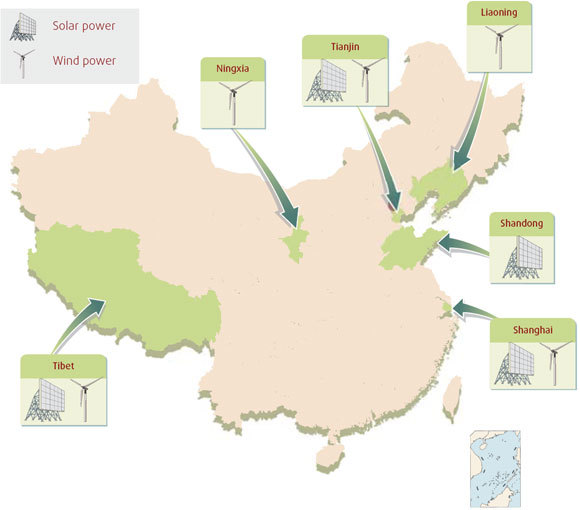Fuxin, Liaoning: Coal to wind
Pan Liguo, mayor of Fuxin in Liaoning province, has an ambitious plan to "turn a coal-dependent city into a city of wind farms".
Fuxin's once-rich coal reserves, the source of both power and huge environmental problems, are expected to last for only another 25 years. In the future, wind coming from neighboring Inner Mongolia autonomous region is expected to fuel the alternative strategy.
Shanghai: Eco-city on island
Shanghai aims to build the world's first eco-city, called Dongtan, on Chongming Island, right off the coast in the East China Sea.
A joint program between the Chinese and British governments, planners said the new city will feature a carefully designed mix of housing, retail shopping, post offices, schools, nurseries and healthcare facilities that minimizes the need to travel long distances for essential services. Most residents are expected to be able to walk or bike to work, school or local shops.
Bicycle paths and walkways will crisscross the city, and buses will be battery-powered. All buildings will be less than eight storeys tall and will incorporate green design technology, including energy-saving insulation, planners said.
The city will generate its own energy by taking advantage of sea wind. A recycling center that will recycle 80 percent of the city's waste will also produce power, and the city will reuse much of its wastewater.
Due to be completed in 2030, Dongtan will have more than half a million residents and also serve visitors with tourist and entertainment attractions. With farmland and parks within walking distance and organic farming practices, it aims to represent a model for environmentally friendly urban development.
Tianjin: Green partnership
Tianjin also will start building of the eco-city of Binhai in July, under a Sino-Singapore cooperation program designed to showcase sustainable development for North China.
The eco-city will be built in the Binhai New Area of Tianjin municipality, a State-level strategic development area approved by the State Council in 2005 for its huge potential for economic growth.
It will consist of 30 sq km encompassing modern living, recreational and business facilities.
The project will take 10 years to complete, and will be important as a marker of North China's future environmental protection as well as in promoting economic development.
Patrick Choy, chairman of the China Financial Leasing Group Ltd and a member of the 11th National Committee of the CPPCC, said the Binhai project will employ railway and light-rail as well as vehicles powered by electricity or natural gas.
The construction and operation of public transportation can draw experiences from Hong Kong's model, in which the government plays a leading role, Choy said.
He predicted that 90 percent of the eco-city's residents will be able to shuttle between office and home by public transport, bicycles or simply walking.
Dezhou, Shandong: Sun city
Its designation as a city of the sun comes not so much from the amount of sunlight it gets, but from its production of solar power equipment.
Dezhou's strengths in the industry will also see it hosting the 2010 International Solar City Congress.
The China Himin Solar Energy Group, known as a major producer of solar water heaters, is seen to be largely behind the city's reputation.
The group reported revenue of 2 billion yuan (US$282 million) last year.
It stopped producing cheap, low-capacity heaters in 2003, and turned to high-quality units, raising prices from 1,500 yuan to 3,000 yuan for each basic model. Now the price for a luxury home unit can be as high as 20,000 yuan.
Even though Himin's heaters are some of the most expensive sold domestically, the company reportedly occupies 14 percent of the market.
Ningxia: Wind power giant
The Ningxia Hui autonomous region will build nine new wind power plants with an investment of US$2.2 billion by 2020.
It is expected to become the country's biggest wind power generator by then, when it possesses an installed capacity of 2.15 million kW, up from 112,200 kW in 2005 - when it already ranked fourth in wind power capacity after the Inner Mongolia and Xinjiang Uygur autonomous regions, and Liaoning province.
Tibet: Renewable highland
The Tibet autonomous region is promoting the development and application of solar power, wind and geothermal energies in several regions, amid efforts to realize the commercialization of renewable energy resources.
Since 2005, the State Grid has invested about 8 billion yuan (US$1.13 billion) to make renewable energy part of its grid.
Faced with technical difficulties in constructing power lines, it plans to connect separate power generators for areas fueled by hydropower, solar power and wind-generated plants.

(China Daily March 19, 2008)